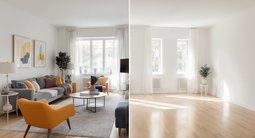TL;DR
If your living room feels cold, start with scale: a big area rug, warmer lighting, and better furniture placement usually fix the vibe before changing curtains. Then pick curtains in one cohesive fabric, like textured linen or pinch-pleat panels, that complement a velvet sofa and echo colors from your rug.
Curtain ideas for velvet sofas: is it the drapes—or the missing layers?

Layering rugs, lighting, and curtains transforms a chilly living room into a warm, welcoming space.
Feeling like your curtains aren’t working with a new velvet sofa? Here’s the thing: most “curtain problems” are actually missing-layers problems.
In living rooms that read cold or “waiting room,” experts recommend anchoring the space with a large area rug, adding warm layered lighting, and arranging furniture so it breathes. Once the bones are right, curtain ideas for a velvet sofa become clear: pick one cohesive fabric, match undertones, and repeat your accent color elsewhere so it looks intentional.
Let’s fix the foundation—then fine-tune the window treatments.
Core strategy: Rug, lighting, and layout first—then choose the curtains
A room looks off when it lacks foundational layers: a large rug (8x10 or 9x12 in most living rooms), warm 2700–3000K lighting, and a layout that isn’t pushed to the walls.
- Start with the rug. Right-size is key: front legs of sofas and chairs should sit on the rug, and the coffee table should land fully on it. In many rooms, that’s at least 8x10; larger spaces often need 9x12.
- Warm the light. Replace cool bulbs with 2700–3000K LEDs and aim for 3–5 light sources: a floor lamp, two table lamps, and dimmable sconces. Overhead-only lighting flattens the room.
- Float the furniture. Pull seating 6–12 inches off the walls, create a conversation zone, and leave 24–30 inches for walkways. Center the TV so the screen’s middle sits near seated eye level (about 42 inches from the floor for most sofas).
Now, curtains. Designers often advise keeping panels in one color/fabric for cohesion, especially beside a statement velvet sofa. Textured linen or linen blends add a soft matte contrast to velvet’s sheen; back-tab or pinch-pleat headers look more tailored than grommets. If you’re renting, you can’t always move the rod, but you can upgrade panels: target a “kiss” hem that just grazes the floor and 2x fullness (total panel width equals roughly twice the window width) for a luxe look.
Color strategy: pick curtains that echo a shade from your rug or art. With warm upholstery (mustard, terracotta), complementary accents like deep olive, teal, or navy help balance all that warmth. Repeat the curtain color in 2–3 places (pillows, a vase, a book jacket) so it feels deliberate.
User insight: people often think curtains are the culprit; once a large rug, plants, and warmer lamps go in, the same curtains suddenly “work.”
Anecdote
A pair of mustard curtains felt too loud beside a new velvet sofa—until the homeowners added a deep green rug and a brass floor lamp. The green bridged the warm tones, the brass added contrast, and the “wrong” curtains became the room’s sunny accent.
Common mistakes and misconceptions
Most “curtain problems” are cohesion problems—scale, undertone, or lighting are usually to blame.
- Too-small rug. A 5x7 under a full seating group makes furniture feel adrift. Use at least 8x10 so front legs land on the rug.
- Overhead-only lighting. Cool, bright ceiling lights make stone or tile floors feel icy. Add warm lamps and dimmers for instant coziness.
- Mixing similar but clashing neutrals. If the beige sofa is pink-beige and the curtains are yellow-beige, they’ll fight. Match undertones or choose a colored curtain that bridges both.
- Matchy-matchy palette. All orange and tan? Bring in a complementary color (green or blue) through art, a rug, or pillows to create depth.
- Grommet overload. Grommet panels can skew casual. If you want polish, switch to pinch-pleat or back-tab styles on the same rod.
Pro tips and expert insights
Experts recommend starting with a color ratio: 60-30-10 for base, secondary, and accent colors.
- Scale and fullness. Curtain width should be roughly 2x the window span for proper pleating. Panels should “kiss” the floor or break up to 1 inch; puddles are optional but can skew formal.
- Rod placement. If you can raise it, 4–6 inches above the window or within 2 inches of the ceiling elongates the room. In rentals, extend rods 8–12 inches past the frame so panels don’t block light.
- Undertone check. Hold fabric against the sofa in daylight; yellow-beige, pink-beige, and green-beige don’t always mix. When in doubt, textured flax linen or cotton-linen blends play well with most velvets.
- Pattern scale. If you pick a patterned rug, choose smaller-scale patterns for pillows or curtains. Avoid repeating identical scale across surfaces.
- Ground with contrast. A few black or espresso accents (frames, lamp bases) keep warm palettes from feeling “floaty.”
Reflection: once the room has a big rug, softer bulbs, and some art, the window treatments stop screaming for attention—and start framing the view.
Anecdotes and real stories
“The rug changed everything.” One homeowner swore the two-tone curtains were wrong. After laying a 9x12 with olive, terracotta, and cream, the curtains suddenly connected—and the space felt twice as warm.
“We floated the sofa.” A curved velvet sofa was glued to the wall, pinching the curtains. Pulling it 10 inches forward and centering the coffee table created a conversation zone; the drapes stopped creasing and looked intentional.
“Art made the color make sense.” A large abstract with mustard and navy landed between wall sconces. Navy pillows and a ceramic pot echoed it, and the formerly “too yellow” curtains became the perfect backdrop.
“Lighting was the real villain.” Swapping cool bulbs for 2700K, adding a floor lamp, and dimming the sconces turned a sterile, glossy floor into a cozy evening scene—no new curtains required.
Visualization Scenario
Picture this: a 9x12 flatweave in olive, camel, and cream grounds your curved velvet sofa. The sofa floats 10 inches off the drapery, flanked by a warm brass floor lamp. Pinch-pleat flax-linen curtains skim the floor, and a large abstract with navy and mustard hangs between the sconces. At night, 2700K lamps glow. The room finally feels like a conversation you want to linger in.
FAQ: curtain ideas, rug sizing, and cozy living room fixes
- How big should my living room rug be?
Most living rooms need at least an 8x10 so front legs of sofas and chairs sit on the rug; larger rooms often need a 9x12 to anchor the seating area. - What curtain color works with a velvet sofa?
Textured linen in a complementary tone—olive, navy, or warm taupe—pairs well with velvet; pick a color from your rug or art and repeat it in 2–3 accents. - How high should I hang curtains in a rental?
If you can’t move the rod, use longer panels that “kiss” the floor and extend the rod 8–12 inches past the window so panels don’t block light. - How do I make a cold living room feel cozy?
Add a larger rug, switch to 2700–3000K bulbs, bring in 3–5 light sources, and layer plants, textiles, and art for warmth and texture. - Is it okay to mix curtain colors?
It can work, but unified fabric and undertone usually look more polished; many designers prefer matching panels and varied accents elsewhere.
Image alt-text ideas and captions:
- Alt: “Velvet sofa living room with large patterned rug and linen pinch-pleat curtains” — Caption: “A single-fabric curtain choice looks tailored against velvet.”
- Alt: “Living room lighting at 2700K with floor and table lamps” — Caption: “Layered warm lighting softens stone floors instantly.”
The takeaway
If your new velvet sofa makes the curtains feel off, fix the foundation first: a larger rug, layered warm lighting, and balanced furniture placement. Then choose one cohesive curtain fabric with the right undertone and repeat its color elsewhere. The right order—rug, lighting, layout, then window treatments—saves money and delivers a room that finally feels like home.
Want to preview curtain colors, rug patterns, and layouts before buying? Try visualizing options with ReimagineHome and test a few looks in minutes.
.svg)

.svg)
.jpg)













.png)